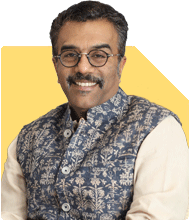Ramalingam Kalirajan |10314 Answers |Ask -Follow
Mutual Funds, Financial Planning Expert - Answered on May 14, 2025
He has an MBA in finance from the University of Madras and is a certified financial planner.
He is the director and chief financial planner at Holistic Investment, a Chennai-based firm that offers financial planning and wealth management advice.... more

Hello, I am 34. I have accumulated a lump sum of 6 lakh from the bonus I received in the last two years. I have fixed deposit with 4 lakh. I don't want to take a high risk but I still hope to see some reasonable growth in the next 5 years to buy a property in my village, approx Rs 1-1.5 crore. Can you suggest suitable investment options like hybrid or short-term debt funds?
Now let’s explore suitable investment options for your 5-year goal, keeping your risk appetite and returns expectation balanced.
Importance of Capital Safety with Moderate Growth
You want moderate growth, but capital safety is also a top concern.
That’s a smart way to think for a short-to-medium term goal like property purchase.
In 5 years, market-linked instruments can give better returns than bank FDs.
But full equity exposure is not suitable due to market ups and downs.
So, we need instruments that balance risk and return effectively.
That’s why hybrid and debt-oriented mutual funds become important to consider.
Hybrid Funds: Balanced Exposure with Controlled Risk
Hybrid funds invest in both equity and debt instruments.
They reduce risk by mixing stable debt with growth-oriented equity.
There are different types of hybrid funds. Each suits a different risk level.
Conservative hybrid funds have 75-90% in debt and only 10-25% in equity.
They suit investors like you who want low risk and better-than-FD returns.
These funds provide stable growth with lower volatility.
Over 5 years, they may offer more than FDs without extreme risk.
Aggressive hybrid funds have 65-80% in equity and rest in debt.
They are not ideal for your current goal due to higher equity exposure.
Stick with conservative or balanced hybrid funds for your 5-year window.
Short Duration Debt Funds: Low Volatility and Steady Returns
These funds invest in bonds with maturity of 1 to 3 years.
They give better returns than savings or FDs with less interest rate risk.
They are ideal if you want predictable income with low risk.
In 5 years, they can perform better than FDs post-tax.
You can consider these for parking the full or partial Rs 6 lakh.
You get easy liquidity and no lock-in period unlike FDs.
These funds suit conservative investors aiming for steady returns.
Banking and PSU Debt Funds: Lower Risk, Higher Quality
These funds invest in safe public sector and banking bonds.
Credit risk is very low as they avoid private sector papers.
They suit people who want safety, liquidity, and reasonable returns.
Not as volatile as long-term debt or credit risk funds.
They provide better post-tax returns than FDs, especially if held long-term.
These funds work well in a stable interest rate environment.
Ideal for you if you don’t want surprises or big risks.
Corporate Bond Funds: Stability with Slightly Better Yield
These invest in top-rated corporate bonds.
The risk is a bit higher than banking & PSU debt funds.
But the return potential is better than short-term FDs.
If you are okay with very limited additional risk, this is worth exploring.
Avoid low-credit-rating debt funds. They come with hidden dangers.
Always check for AAA-rated securities in these funds.
Dynamic Asset Allocation Funds: Adjust Automatically
These funds move between equity and debt based on market trends.
In bull markets, they increase equity. In bear markets, they increase debt.
You don’t need to time the market yourself.
They are good for medium-term investors like you.
Though they carry more equity risk than conservative hybrid funds.
If you’re open to small equity exposure, this type may work.
Choose only those funds with proven consistency over 5+ years.
Keep FD as a Backup, Not Main Investment
You already have Rs 4 lakh in fixed deposit.
That’s a strong emergency reserve or parking fund.
Don’t rely entirely on FDs for your Rs 6 lakh bonus.
FD returns may not beat inflation over 5 years.
So diversify your savings beyond traditional FDs.
How to Divide the Rs 6 Lakh for Better Outcome
Here’s a sample allocation approach based on your goals:
Rs 2.5 lakh in conservative hybrid funds for mild equity exposure.
Rs 2 lakh in short duration debt funds for safety and growth.
Rs 1.5 lakh in banking & PSU or corporate bond funds.
This mix offers low risk, moderate returns, and good liquidity.
Review the mix yearly and rebalance if needed.
SIP Option Also Worth Considering
Even for lump sum, you can deploy in 3-6 monthly tranches.
This reduces market timing risk if choosing hybrid funds.
You can use STP (Systematic Transfer Plan) from liquid fund to hybrid fund.
This gives peace of mind and disciplined investing.
Taxation on Mutual Funds: What You Need to Know
Equity-oriented hybrid funds have new tax rules now.
LTCG above Rs 1.25 lakh is taxed at 12.5%.
STCG is taxed at 20% for equity funds.
For debt mutual funds, gains are taxed as per your income slab.
But post-tax returns of mutual funds can still beat FD returns.
Why Not Index Funds or ETFs for This Goal?
Index funds may seem low-cost but have limitations.
They copy the market. No chance to beat the market.
You carry full market risk without any downside protection.
In volatile times, actively managed funds protect better.
Certified Financial Planners often prefer active funds for mid-term goals.
Especially when capital protection is equally important.
Avoid Direct Funds Without Guidance
Direct mutual funds may have lower expense ratio.
But they offer no advisor support or guidance.
Choosing the wrong fund in direct mode can cost more.
Regular plan through a qualified Mutual Fund Distributor with CFP support gives tailored advice.
That helps in rebalancing and tax planning too.
Avoid Over-Diversification
Don’t choose too many schemes just to feel “safe.”
Stick with 3-4 good schemes that align with your goal.
Too many funds dilute returns and become hard to track.
Quality over quantity always works better in mutual fund investing.
Monitor and Reassess Yearly
Every year, review performance of your funds.
If returns are way off your expectations, consider switching.
You can also reduce equity exposure as you approach the 5th year.
This protects your capital from last-minute shocks.
Emotional Discipline is Very Important
Don’t chase high returns or panic during market drops.
Focus on staying invested for full 5 years.
That’s when compounding and averaging truly work.
Emotional discipline beats clever timing every time.
Finally
You’ve made a solid start by saving Rs 6 lakh with intention.
Use this amount wisely by diversifying across hybrid and debt funds.
Avoid going fully equity due to the short investment horizon.
Stick with high-quality funds, reviewed annually.
Keep your FD as liquidity cushion, not for wealth building.
Work with a Certified Financial Planner if you need hand-holding.
This way you’ll grow your capital safely, and meet your goal in 5 years.
Best Regards,
K. Ramalingam, MBA, CFP,
Chief Financial Planner,
www.holisticinvestment.in
https://www.youtube.com/@HolisticInvestment
You may like to see similar questions and answers below
Ramalingam Kalirajan |10314 Answers |Ask -Follow
Mutual Funds, Financial Planning Expert - Answered on Jul 13, 2024
Ramalingam Kalirajan |10314 Answers |Ask -Follow
Mutual Funds, Financial Planning Expert - Answered on Jul 23, 2024
Ramalingam Kalirajan |10314 Answers |Ask -Follow
Mutual Funds, Financial Planning Expert - Answered on Aug 04, 2024
Ramalingam Kalirajan |10314 Answers |Ask -Follow
Mutual Funds, Financial Planning Expert - Answered on May 24, 2025
Ramalingam Kalirajan |10314 Answers |Ask -Follow
Mutual Funds, Financial Planning Expert - Answered on May 26, 2025
Nayagam P P |10469 Answers |Ask -Follow
Career Counsellor - Answered on Aug 23, 2025
Nayagam P P |10469 Answers |Ask -Follow
Career Counsellor - Answered on Aug 23, 2025
Nayagam P P |10469 Answers |Ask -Follow
Career Counsellor - Answered on Aug 23, 2025
Nayagam P P |10469 Answers |Ask -Follow
Career Counsellor - Answered on Aug 23, 2025
Nayagam P P |10469 Answers |Ask -Follow
Career Counsellor - Answered on Aug 23, 2025
Chocko Valliappa |526 Answers |Ask -Follow
Tech Entrepreneur, Educationist - Answered on Aug 23, 2025
Chocko Valliappa |526 Answers |Ask -Follow
Tech Entrepreneur, Educationist - Answered on Aug 23, 2025
Chocko Valliappa |526 Answers |Ask -Follow
Tech Entrepreneur, Educationist - Answered on Aug 23, 2025
Nayagam P P |10469 Answers |Ask -Follow
Career Counsellor - Answered on Aug 22, 2025
Nayagam P P |10469 Answers |Ask -Follow
Career Counsellor - Answered on Aug 22, 2025


















